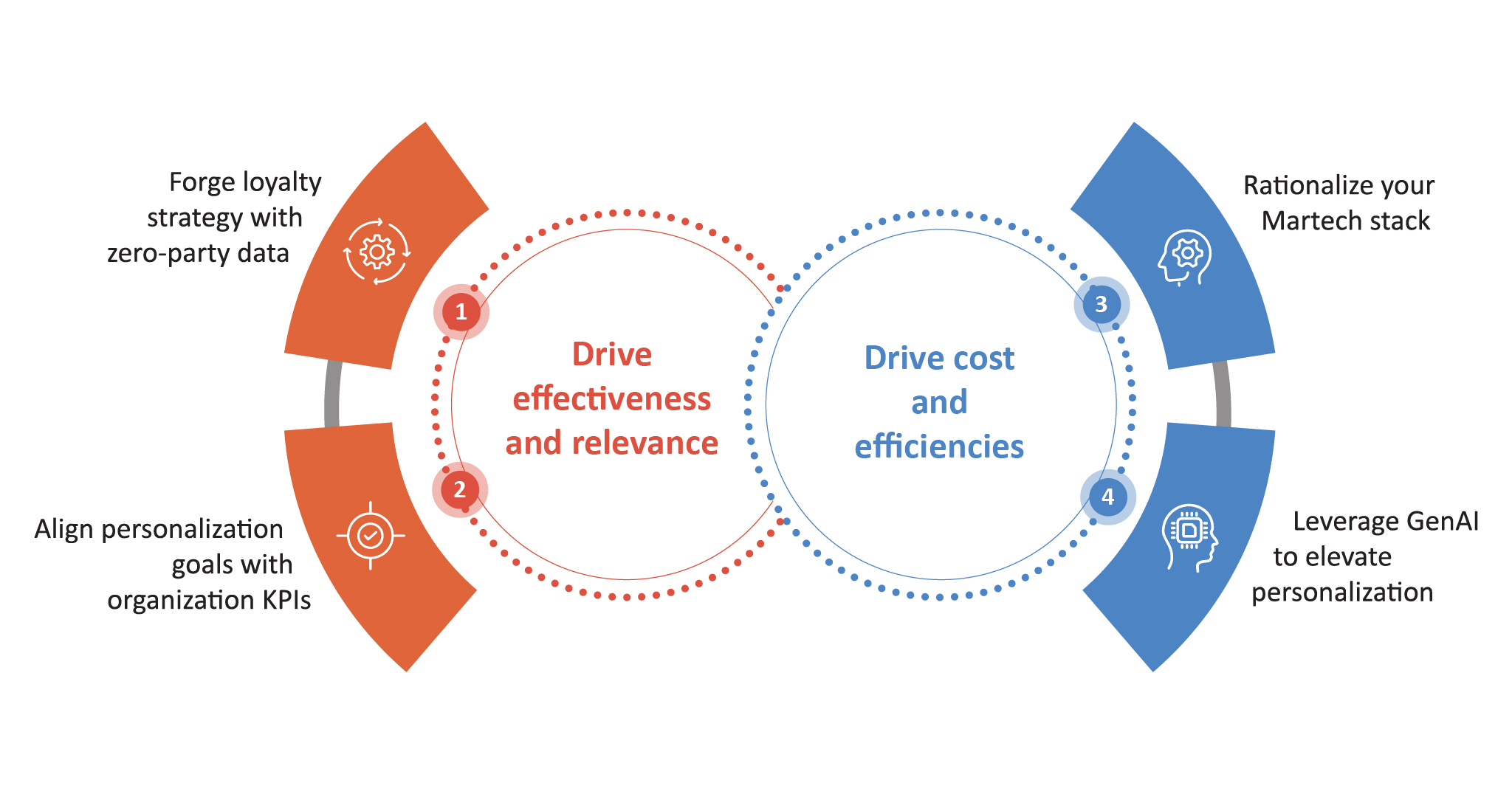Industry
HIGHLIGHTS
- Third-party cookie restrictions and privacy regulations make access to customer data challenging.
- Yet, customers expect every brand interaction to be personalized.
- Zero-party data, a tiered personalization strategy, and a framework for maximizing personalization outcomes will help brands and retailers improve loyalty and customer lifetime value (CLV).
On this page
The personalization gap
The distribution of known and anonymous customers in retail is disproportionate.
This is leaving retailers in a tizzy as they are looking to drive similar experiences for all customers. It’s baffling that retailers are going all out to build a 360-degree view for just 10% of their shopper base that has identified itself, while an overwhelming 90% of shoppers continue to remain anonymous, making personalization for all seem like an illusion. This is likely to become more challenging with paradoxical trends such as data deprecation and customers increasingly expecting personalized experiences.
Data deprecation refers to data losing its value over time. There are many forces accelerating data deprecation. These include intentional consumer actions such as ad blocking, closed ecosystems, or walled gardens that disallow access to first-party data and cross-platform customer data exchange. Additionally, third-party cookie restrictions, and privacy regulations such as general data protection regulation (GDPR) also contribute to data depreciation.
Tiered approach for personalization
Before the ‘cookie apocalypse’, retailers had troves of customer data to power their personalization strategies.
Today, with restricted access to new consumer data, retail businesses make do with whatever data they had acquired earlier, failing to build deeper connections with their customers. Customer expectations are also unique—loyal customers demand exclusivity in terms of offers and services, while new customers are wary about sharing a lot of personal information with brands.
Whether retailers should gear their personalization initiatives only toward known customers is a moot point. However, most retailers focus on elevating the user experience of new users, so that they eventually feel comfortable sharing information about themselves. Retailers can adopt a tiered approach to deliver personalized experiences for all:
- For customers about whom retailers have limited information, retailers can drive segment-wise personalization.
- For anonymous customers, retailers can deliver personalized experiences by tapping into their in-session behavioral trails such as clicks, searches, views, and navigation.
- For loyal customers who have higher expectations from brands, retailers can go granular, leveraging abundant data available, including zero-party data.
What is zero-party data?
Zero-party data refers to data that customers explicitly share with a clear understanding of how retailers will use it.
Examples of zero-party data include information such as communication preferences, product preferences, and personal style provided by customers by participating in polls, surveys, and contests. First-party data is collected by retailers by analyzing or tracking customer interactions with brand. For instance, purchase history, page views, and dwell time. On the other hand, zero-party data is shared by customers, making it more authentic and reliable and helping retailers build the elusive golden record for each customer.
Maximize marketing ROI with less data
In the future, retailers will need to rely on zero-party data.
Therefore, retailers must learn how to optimize their efforts for marketing ROI with less data. This comes at a critical juncture amid other challenges and opportunities such as heightened customer expectations, a heavy and crumbling MarTech stack, and the emergence of new technologies such as generative AI (GenAI). A focused approach on maximizing personalization outcomes with limited resources and driving cost efficiencies with wise investment choices (see Figure 1) can help retailers drive significant value exchanges across the customer lifecycle.
The following strategies will help retailers make efficient use of data.
- Forge loyalty strategy with zero-party data: As privacy regulations become more stringent, brands that prioritize collecting and leveraging zero-party data to power their loyalty programs will be better positioned to deliver meaningful and personalized experiences and improve customer lifetime value (CLV).
- Align personalization goals with the organization’s key performance indicators (KPIs): While accountability is a key lever for driving loyalty, accountability wrests with stakeholders spread across the organization with varied KPIs such as average order value (AOV), conversions, CLV, and net promoter score (NPS). Hence, it is often prudent to objectively evaluate the end consumer’s needs, understand key organization KPIs that require improvement, and prioritize the type of intervention and use cases required to meet both customers’ needs and organizational KPIs concurrently.
- Rationalize the MarTech stack: Retailers must eliminate redundancies by evaluating their MarTech landscape. They must invest in microservices-based modular solutions that cater to specific personalization goals instead of opting for an entire solution. Solutions that can seamlessly integrate into the existing ecosystem along with pointed GenAI use cases will not only help them realize cost efficiencies, but also reinforce a better and connected customer experience.
- Leverage GenAI to elevate personalization: Artificial intelligence (AI), GenAI, and large language models (LLMs) provide significant opportunities for processing unstructured data. They augment creativity in content generation, targeting, and delivering a conversational experience. Several retailers have already launched GenAI-based assistants for product discovery, driving personalized shopping experiences and helping customers make better product purchase decisions.
Improving customer lifetime value
As marketers navigate a world where third-party cookies are increasingly restricted, zero-party data is gold.
Brands that prioritize zero-party data are better positioned to deliver personalized digital experiences while respecting customer privacy. However, they must avoid the trap of collecting more and leveraging less. They must leverage zero-party data effectively, focusing on transparent value exchange. Above all, retailers must use zero-party data with clear intention—improving customer retention, maximizing baskets, or improving customer lifetime value. They must align business goals with the overall customer experience and personalization strategies, which will significantly maximize personalization outcomes.

